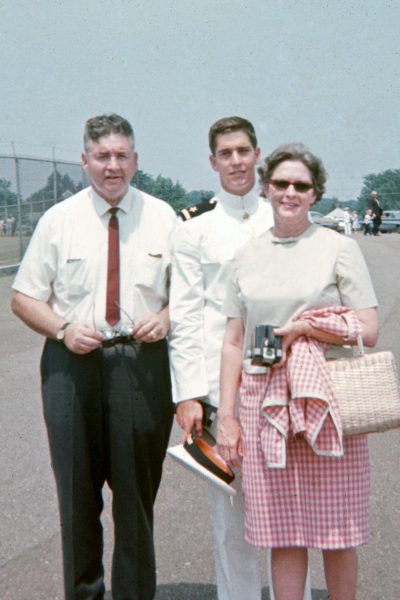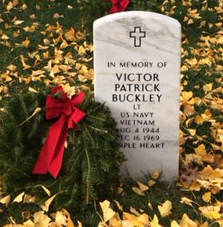This is the unfinished story of my brother, Lt. V. Patrick Buckley, USN.
Pat was a graduate of the United States Naval Academy, class of 1966; our father, Russell Buckley, was class of 1939, and our brother, Russell Buckley, Jr. was class of 1964. Our family considered military service to our nation a proud and noble undertaking. But never could we have prepared ourselves for what was to happen in the Viet Nam war.
Pat was a Naval Aviator who flew a jet aircraft, the RF8G Crusader, equipped to gather intelligence by taking pictures of the enemy. In December of 1969 he was part of a photo reconnaissance detachment flying from the aircraft carrier USS Hancock (CVA 19) operating in the Gulf of Tonkin. At about mid-day on December 16th Pat and his fighter escort flew a mission to photograph the Ho Chi Minh trail. They were shot at but there was no indication that either was hit.
While returning to the aircraft carrier, the fighter escort needed mid-air refueling and took the lead to descend and rendezvous with the airborne tanker prior to returning to the aircraft carrier. My brother, who was in the lead, acknowledged the standard lead change signal and drifted aft. That was the last time Pat was seen or heard from.
An at-sea search was conducted for aircraft wreckage, but none was found, and no emergency distress signals were heard. In the absence of more conclusive information, my brother was listed as Missing-in-Action (MIA). Two years later we were informed by the Deputy Secretary of Defense that there was “no available evidence to indicate a reasonable expectation that identifiable remains will ever be recovered.” Pat’s status was changed from MIA to Killed-in-Action, body not recovered (KIA, bnr).
The family still held hope that he was a POW; my mother and I sent yearly packages under the auspices of the Red Cross, but most years they were returned to us unopened. Still we hoped. We attended meetings of POW/MIA families. But, we did not hold any memorial or funeral services, praying he would return with the POWs. When Pat was not among the returning prisoners, the family began to accept the fact that we had lost our 25-year-old brother. Under the direction of members of his squadron, we helped establish a perpetual scholarship in his name, we visit the Wall often, and in 2007, we finally arranged a military funeral with a memorial marker placed in Arlington Cemetery. Something our parents never had the heart to do.
However, in recent years my siblings and I have re-engaged in pursing more answers to discover what happened. We have gone through documents and accounts of the incident, talked to other pilots who flew the same aircraft in the Viet Nam conflict, some of whom knew my brother, attended a recent DOD sponsored family meeting in Phoenix, and written letters we hoped might help us get answers. In that process, we discovered a number of things that we thought might shed light on the events of that day in 1969.
At the time, Pat disappeared following the lead change, his aircraft was 30 miles from the carrier, and although the nearest land was the coast of North Vietnam approximately 45 miles away, he was headed in the general direction of Hainan Island, China. Perhaps most significantly, his aircraft was known to have approximately one hour and fifteen minutes of additional flying time. The scuttlebutt among other F8 pilots was that he could have easily flown over and been shot down or crashed on Hainan Island. Given that information, and the fact that the initial two-day search of the Gulf of Tonkin found no trace of his plane, it is difficult to accept as fact that Pat was definitively lost at sea. It seems feasible he could have gone down over land as easily as over water.
And so, we are asking, can’t more be done? Work with the Chinese to see if there are records of downed aircraft over Hainan, China on midday December 16, 1969? Renew efforts for land-search in Viet Nam? Perhaps use improved technology to search the floor of the Gulf of Tonkin; certainly, there are many other aircraft there. So far, we have gotten no positive response to these questions.
And so, this story is unfinished as are many others from that long and difficult war. Our brother was one of many who died too young. We may never get answers, but we are not quite ready to stop trying.



